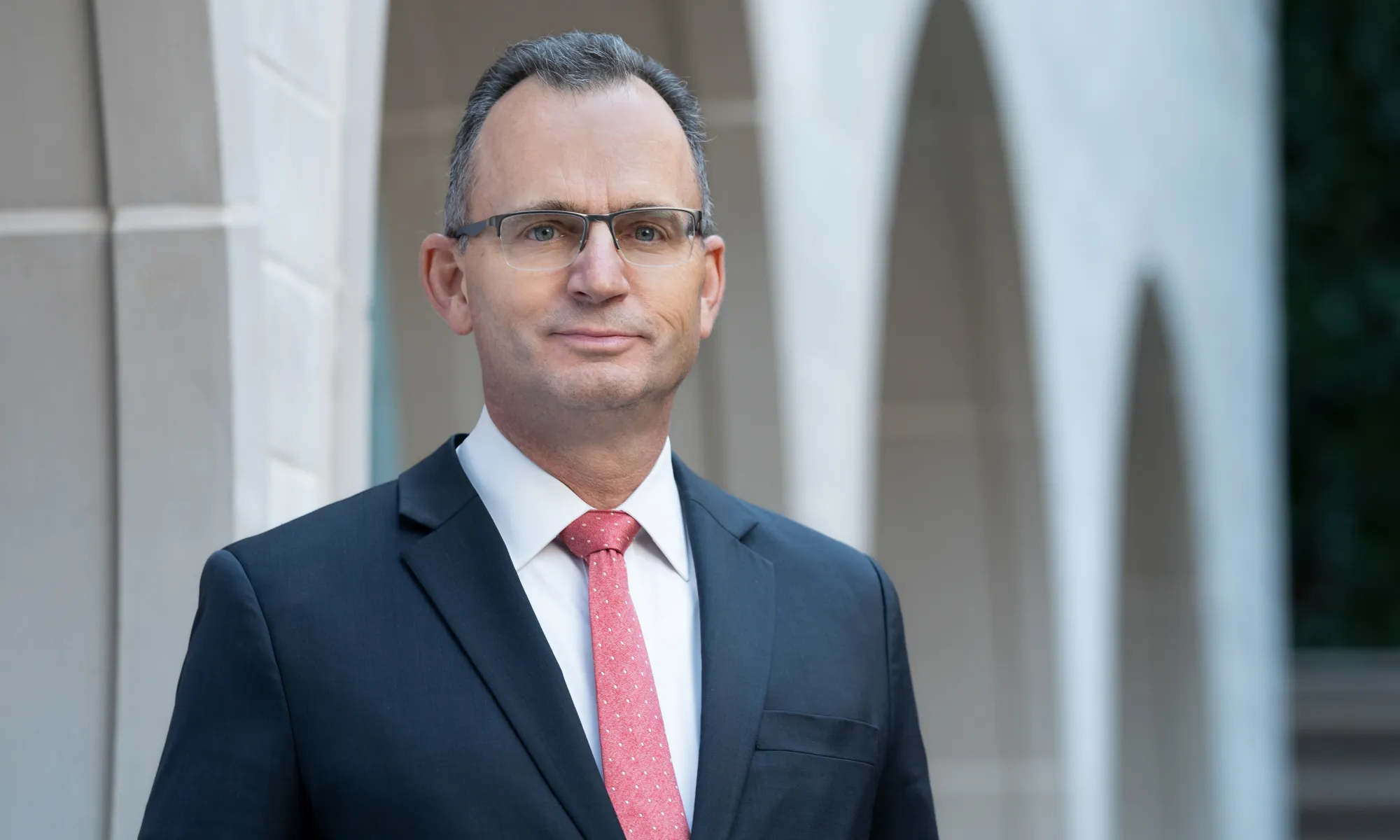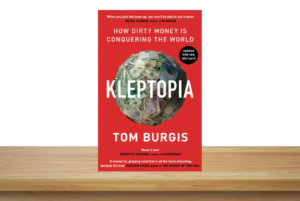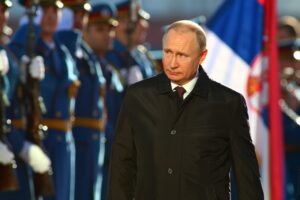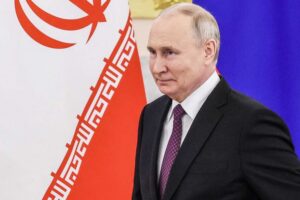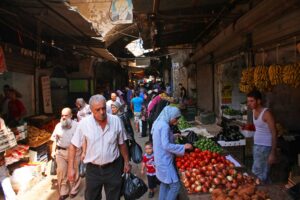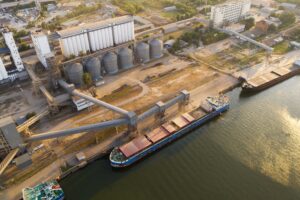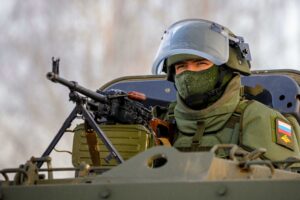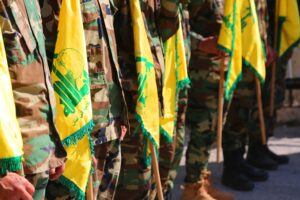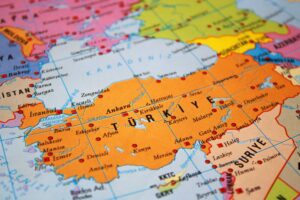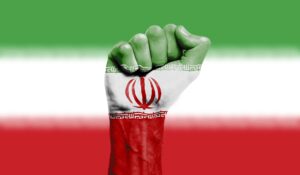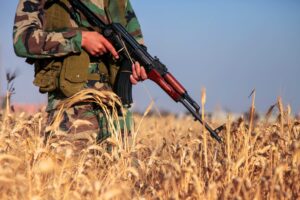
Paul Salem. Credit: Middle East Institute
Paul Salem, the President of The Middle East Institute, speaks to Jemima Baar, the Senior Editor at Manara, about his experiences living in Beirut during the Arab Spring, his observations about its origins and fallout, and his predictions for the future of the region.
JEMIMA BAAR: Paul Salem, thank you for taking the time to speak with Manara. You were in Beirut in your role as the founding director of the Carnegie Middle East Center between the years of the Arab Spring. Could you tell us about what you saw and observed?
PAUL SALEM: I was in Beirut and I had colleagues [from my days of activism promoting democracy, human rights, and transparent government] who were Egyptian, Tunisian, Moroccan, and Jordanian, so I also followed what was happening in their countries. The uprisings were not sparked by liberal democratic types; they were sparked initially by a desperately poor person in Tunisia. However, this quickly triggered civil action and a movement in Tunisia, Libya, Egypt, Syria and so on, which had, surprisingly, much wider popularity than they thought. I remember talking to friends who organised the January 24 (2011) protest in Egypt, which was the beginning. They were hopeful that they could get maybe 2,000 people out on the street. On that day, half a million people showed up. So, [the movement] touched a nerve that was far bigger.
It was a tremendously heady, hopeful period of time. One phenomenon that was remarkable was this idea of protesting in the name of accountable government, bringing down autocratic regimes, holding elections… all of that garnered wide appeal among the liberal democrats but also a fair number of Islamists, a fair number of leftists, as well as [ordinary] people who were just fed up and willing to try this new approach.
There is still something called the ‘Arab political space’. When the Iranians rose up in 2009, it did not ripple. When the Turks protested for democracy, it did not ripple. But when it was done in Arabic, it rippled.
It’s also remarkable that what happened in one Arab town became, in just a few weeks, a pan-Arab phenomenon. It was, of course, aided by Arabic television, social media and all of that, but it indicated something interesting: that there is still something called the ‘Arab political space’. When the Iranians rose up in 2009, it did not ripple. When the Turks protested for democracy, it did not ripple. But when it was done in Arabic, it rippled. That’s interesting because although there are 22 different Arab states, they really are interconnected in some important way.
Then, there was a period of excitement [surrounding] how to organise and make something of it. Then it gets into the different trajectories. So, there’s the story of the uprising itself. Then there’s the story of the election and social contests, which was largely won by Islamists. Then there’s the story of how the regimes reacted. And in the background of all of that is how the region reacted.
The obvious lesson was that this liberal democratic thing was great for protest, but it was not prepared to win elections. Islamists were much better, unsurprisingly. There were the very different reactions by the different governments. The Tunisian state accommodated it, with the army standing aside and enabling a transition. Egypt initially enabled it and then turned against it. Bahrain sent in troops from the get-go. Libya split into civil war. Syria went to arms. And then, [there was] the region’s reaction, mainly led by some of the Gulf countries. Qatar kind of encouraged it, figuring that the Islamists would come out on top, as did the Turks, whereas the UAE and Saudi Arabia discouraged it, fearing democracy itself, but fearing the Islamises winning the elections more so. The region largely reacted against it, which kind of doomed it.
You mentioned Tunisia and how it has been one of the few success stories of the Arab Spring. What, in your view, went right in some countries, and what went wrong in others?
There are very few old, cohesive nations in the Arab world. Tunisia is one of them.
Firstly, Tunisia is a very cohesive nation. There are very few old, cohesive nations in the Arab world. Tunisia is one of them, as is Egypt. Syria, Iraq, Yemen, Lebanon, Sudan and Libya are not. [Tunisia] was therefore unlikely to descend into civil war [because] it’s not divided.
Secondly, Tunisia has one of the oldest modern histories of constitutionalism and rule of law. Its constitutional history, like Egypt, goes back to the middle of the nineteenth century with attempts to modernise and constitutionalise. It was then reinforced by Habib Bourguiba who was, yes, an autocrat, but someone who emphasised secularism, women’s empowerment, civil society, and the labour movement. Hence, there is a strong and committed secular movement in Tunisia, which does not exist anywhere else in the Arab world. Yes, you have secular people, but they’re not ‘hardcore’ secularists [in the rest of the Arab world].
Thirdly, the role of the army. The Tunisian army was never the ruler of Tunisia. Egypt, after 1952, and you might even say going back to the Mamluk history, has been governed for a long time by its military. Tunisia did not have those factors. Its Islamist movement was strong, but there’s a lot to be credited to the leader, Rached Ghannouchi, who was wise. Leadership matters and Tunisia had the good fortune to have the secular movement run by another long-time wise, capable leader. The two of them, through leadership, were able to avoid a collapse in Tunisia and find a way forward.
Regarding the external environment, Tunisia was not of much concern to Iran, or the Gulf, or even to Turkey, so nobody mucked around in it that much. It is also much closer to Europe, which casts a long shadow. All of those [factors] were favourable to the Tunisian example.
Egypt is a cohesive nation, which is why it didn’t sink into civil war like Syria, Yemen, Iraq or Lebanon. But its secular movement is not at all as strong or unified.
I would make one comparison with Egypt. It is a cohesive nation, which is why it didn’t sink into civil war like Syria, Yemen, Iraq or Lebanon. But its secular movement is not at all as strong or unified. It has an army which runs the country, ran the country, and always has the ambition to come back and rule the country. There was just a brief hiatus where the army – partly maybe to prevent Jamal Mubarak coming to power – allowed an uprising. Then, within a couple of years it found its way back into power, which was probably its plan all along. Moreover Egypt, again going back centuries, indeed, millennia, is a completely state-dominated society. The state is always strong, so the trajectory for Egypt is typical for Egypt: the state and the military just run the place.
I’d like to focus on those countries that have experienced civil wars, particularly in light of the book you edited with Ross Harrison, Escaping the Conflict Trap. Could you first define what you meant by the ‘Conflict Trap’?
The Conflict Trap – you can also think of it as a conflict system – is a trap because it’s hard to get out of it. It’s the condition that the Middle East finds itself in at two levels.
At one level, when you have states that collapse, this naturally draws in external powers, both regional and international. Once one power comes in the other power needs to come in as well in order to counterbalance or defend, or deter, or whatever. It’s a trap in the sense that it becomes unavoidable and hard to extract from.
With the Iranians gaining power in Yemen, the trap entailed that the Saudis went in. And when they went in, the Iranians had to double down. The same is true, albeit with different dynamics, in Libya.
Take Yemen, for example. It was doing well for a while, there was a transition, and then without getting into what happened, it collapsed. The Iranians were backing the Houthi faction. With the Iranians gaining power in Yemen, the trap entailed that the Saudis went in. And when they went in, the Iranians had to double down. The same is true, albeit with different dynamics, in Libya. When you have failed states, they begin to draw in powers, and as powers are drawn in, they draw in other powers. It becomes like a sinkhole. The calculus of each country, therefore, is that they can’t get out because [the other power] will win. That’s part of the entrapment.
Several, but not all states have put themselves in a regional conflict system, rather than a regional co-operation system. That means that the region is in an arena of conflict where no-one can pull back.
The second level is region wide. The region’s states – several of them, but not all – have put themselves in a regional conflict system, rather than a regional co-operation system. That means that the region is in an arena of conflict where [no-one] can pull back. The U.S. is part of that conflict system. It has been in conflict with Iran for 41 years and Iran is in conflict with the U.S. and with all of America’s allies. The U.S. has [also] backed Israel since at least 1967 and Israel aggravates [many nations] in the region.
Those are the two vertical and horizontal factors which is why [the region] is in a conflict system.
You’ve talked about regional powers and regional conflict. Would you say that when it comes to civil conflict, in terms of their origins and drivers, that it’s that constant regional power-play in the background? Or are there other factors? How would you weigh them? Are there any commonalities in origins and drivers of civil conflict in the region that you have observed?
I would weigh [civil conflicts] as domestically driven when they start. Then, when [the state] collapses, that is when outside powers are drawn in. The Russians didn’t come [into Syria] until three to four years after [the conflict] started. The Iranians didn’t send people for nearly a year. [It’s the] same in Yemen and Libya.
Crisis-ridden socioeconomic situations, young people wanting jobs and housing… These economic crises really began in the 1980s, when states that had been popular, developmental, and forward looking, turned crony-capitalist and exclusionary.
The collapse of these political systems is driven by obvious domestic factors: shrinking, crisis-ridden socioeconomic situations, young people wanting jobs and housing… These economic crises really began in the 1980s, when states that had been popular, developmental, and forward looking, turned crony-capitalist and exclusionary. They could no longer please [their] people through socioeconomic success and progress, so turned to repression and the police state. Of course, they lost the initial populist legitimacy they had enjoyed in the 1950s and 1960s. They became strained economic and political systems, [so when] you had this wave of hope and empowerment, people suddenly felt that they could overthrow these systems and bring something better to the fore.
The essence of civil conflicts is domestic and then the external powers either come to complicate it or to fix it.
That moment took different trajectories. I would say the essence [of civil conflicts] is domestic and then the external [powers] either come to complicate it or to fix it. When Yemen had its initial troubles, it was the international region – the Gulf Co-operation Council with international support – that came and ensured a peaceful transition. That was ruined by (ousted President) Ali Abdullah Saleh, then the Iranians came in, then the Saudis, and then it became a problem. Libya has gone back and forth. The international community has played a big role in trying to fix it and move it forward with fitful success. But external contentions – Turkey versus the UAE, Egypt, and Russia – have caused problems. So, part of the external makes it worse and part of the external makes it better. In Syria, the internal [factors] are really what are horrible. President Assad refuses to negotiate [even though] the Americans and Russians tried, and the Iranians were also favourable to some compromise.
On that point about whether there is any sort of prospect of drawing the Syrian conflict to a close – you’re right, there have been about 9 rounds of UN-mediated peace talks as well as the Astana process set up by Russia, Iran and Turkey, which started all the way back in 2017. We’re four years after that, and the conflict has not been resolved. What, in your view, ought to be done to try and draw it to a close?
The reality of it, which has been made clear by Bashar Al-Assad, is that his approach is to take back all of the country by force. He’s made it very clear that there will be no political discussion. Now, if you analyse it it’s because he can’t afford politics: he’s not legitimate, he will never be legitimate. If he allows negotiation or a pathway towards real politics, his position becomes more and more precarious. Talk about conflict trap, he’s put the Alawite community in a death spiral because now, whenever he falters, the Alawites will pay a heavy price. So that’s his strategy.
There are two parts of the country that are not under his control. One is the Turkish zone [in the north-west] and one is the American zone [in the north-east]. That’s up to the Americans and Turks. If the Americans leave, [Assad] will take back north-eastern Syria. The Americans might, half-heartedly, encourage dialogue between the Kurds and the Syrian regime. So, it’s possible that north-eastern Syria could come back under Assad’s control through some sort of deal with the Kurds. That’s conceivable and then the Americans would leave. Or, the Americans do not leave; [after all] they stayed in northern Iraq for many years, and I don’t think Biden is in a hurry. For the Turks, that’s up to Erdogan. He doesn’t look like he’s in any mood to compromise with Assad or leave. So, as he doesn’t want to leave, that part of north-western Syria will remain under Turkish control.
The regime is stable and safe, and that’s all Assad and his group care about – the regime.
There is no, to my mind, sadly… I mean, one should try negotiations… but I don’t see that [they would] bring about anything other than [wasting] time and talk. I think the Assad regime is “happy” with where it is now. If it doesn’t have all of Syria for now, no big deal. At the end of the day, they don’t have money or resources, so they wouldn’t know what to do with it if they had it. The regime is stable and safe, and that’s all Assad and his group care about – the regime. If they get north-east Syria, fine. If they don’t, fine. If they get north-west Syria, fine. If they don’t, fine. They’re not focused on reconstruction; they’re focused on bitter survival.
I therefore don’t see a near-term ending for the Syria conflict. At best, it will remain a frozen conflict. It’s not solvable [for now]. Cyprus hasn’t been solvable… Lebanon wasn’t solvable from 1975-1989… look at Korea, it became two Koreas. Syria is not solvable [and so] one solution is to stop fighting it.
It’s interesting because, meanwhile, you have neighbouring Iraq with a relatively new government that is emerging into a post-ISIS, post-COVID world. Of course, the dynamics in Iraq and Syria are different, but Iraq, on the other hand, has dealt with conflict within its borders for long before the Arab Spring. What would you suggest has enabled the Iraqis to get to this level of relative stability and what do you think it will take to sustain this stability into the next decade?
Well, of course, [it’s a] precarious stability. There are elements of stability that are also elements of instability.
What I mean by that is that, firstly, it has transitioned to an inclusive power-sharing electoral democratic mess. The positive side is that they have that post-dictatorship feeling that the Syrians hoped to get to. The vast majority of Iraqis, despite the mess, despite everything, say [they] would rather have this messy, inclusive democratic power-sharing system than what they used to have.
The demographics of Iraq are both an asset and a liability. In terms of its assets, it is a pluralistic country, which means that it is becoming more resistant to dictatorship.
Secondly, the demographics of Iraq are both an asset and a liability. In terms of [its] assets, it is a pluralistic country, which means that it is becoming more resistant to dictatorship. It’s hard to be a dictator in Iraq because either the Kurds won’t like it, or the Sunnis won’t like it, or the Shi’ites won’t like it. This makes it a bit like Lebanon. There’s not enough of a demographic majority to foster a dictator, unlike in Egypt or Algeria. So, Iraq also has that going for it but it’s also a liability in that there’s a demographic mess and there’s still in-fighting.
Thirdly, again, mixed blessing: Iraq has a lot of oil wealth, which Syria and Yemen do not. This enables it, when oil prices are decent, to manage itself. But there are also curses. One, oil is eminently corruptible, and hence creates an extremely corrupt system. Two, it creates an economy that is dependent on external prices [with] no control over its economic future.
I would say, yes, Iraq is on a very long learning curve. It may not get there, [but] it may get there regarding how to manage a pluralistic, inclusive, democratic (with a very small ‘d’) system without democratic traditions really to speak of [and] how to grow an economy with an exceedingly corrupt political class. There’s a lot going for it, but it’s going nowhere fast.
Picking up on your point that Biden’s not in a hurry to leave northern Syria, I get the sense that, in terms of Middle East policy, Biden’s primary focus is Iran. What role, therefore, if any, do you envisage the Biden administration playing regarding civil conflict in the region?
You’re absolutely right. Biden’s number one, two, and three priority is a nuclear deal with Iran. The reasons for that are domestic and personal. [It was] the same with Trump. I always said that Trump’s main strategic enemy in the nuclear deal with Iran was Barack Obama. He hated Barack Obama and everything Obama did. Had Obama gone to war with Iran, Trump would have wanted peace with Iran. Whatever [Obama] did, Trump wanted to do the opposite.
It’s the same for Biden. This was Biden and his friend, Barack’s deal. Alongside the geostrategic and geopolitical reasons, it’s all personal and political for Joe Biden. That’s why the nuclear deal is on a whole another level amongst all other Middle East policy issues. Once Biden gets the deal back, the rest of the stuff with Iran falls six levels in importance. Really, it’s not a front burner. He wants the deal back, period. I think it will be tricky but they’ll find a way.
The Biden administration believes in multilateralism - you negotiate and play the game, which means that they will pay attention to civil conflict.
Regarding other issues in the region, this administration has a strong diplomatic theme. Even if Biden is busy with other things and even if the Middle East is no longer a high priority, which it is not, the diplomatic bandwidth accorded to the Middle East will be there. That includes trying to negotiate at least a de-escalation in the Yemen war, [where] they’ve sent a special envoy. They want to keep Iraq stable. They’re moving quickly on Afghanistan. They’re scratching their heads about what to do with Syria. They’re not currently engaged in Libya, but I know that they will accord that some attention.
This team believes in stability and negotiating things painstakingly towards some acceptable endgame. They also believe in multilateralism in the sense of reaching out to allies and enemies; for example, engaging Russia, China, Pakistan, and Iran in the Afghanistan process. That’s stunning. That’s their view of international relations – you negotiate and play the game, which means that they will pay attention to civil conflict.
Finally, turning back to where we began – in Lebanon. In some ways, it has escaped the last decade of chaos that many countries in the region have been engulfed by. But at the same time, it does seem to be at a decisive moment. There are some fearing the disintegration of the state and possibly the descent into civil war again, or at least some civil strife. So, drawing on your observations of civil conflicts in the region, especially in the past ten years, but also more broadly your understanding of Lebanon and its history: what do you think will happen and, if disintegration is imminent, what do you think can be done to prevent it?
It was not an uprising out of the blue that was mainly political with some social elements. It was an economic collapse that pushed people into the streets and made it a political matter in Lebanon.
First of all, to look at the causes and drivers: the crisis in Lebanon resembles the economic collapse in Venezuela or Greece. The essence of this crisis is a complete collapse of the banking, monetary, fiscal [systems], and economy itself. The remedy – what’s needed at the core of it – is getting the economic, fiscal, and banking systems going again. That collapse is straining a rickety, dysfunctional, and messy political system. But that’s also important to read: it was not an uprising out of the blue that was mainly political with some social elements. No, it was an economic collapse that pushed people into the streets and made it a political matter. That’s the essence of it.
It is [therefore] not a civil war. The uprising was anti-civil war. They just want better government. However, there is obviously the risk that if the state finally collapses, which is what happened in 1975, the attendant insecurity may ultimately lead to the Conflict Trap. The Shi’ite community already has a militia, and if the state collapses, everyone has to have a militia or else they’re done for. Then you have a civil war. So, it’s not designed. But an economic crisis could lead to a political collapse, which could lead to a collapse of the army, which could lead to a civil war. So yes, it’s a very dangerous moment, but I would describe it in those terms.
And looking at those terms, I would say the most urgent remedy is the economics. Fixing the economics will help the social part. So, like in Greece, Venezuela or Argentina, Lebanon needs a government that will quickly negotiate with the IMF and the international community, commit to a number of reforms, and get a rescue package and a serious strategy to restructure the banks, refinance them, get them the system flowing again, and stabilise the currency. Countries have gone through fiscal, monetary, banking, economic crises many times. Sadly, Lebanon is going through all four of them at once, so it’s pretty acute. But it’s knowing how you fix these things, and if you fix those, then you have a lot of wiggle room. Yes, the state needs form, yes, there’s corruption, and a new generation… but that goes back to more normal politics.
Paul Salem is the President of The Middle East Institute, a non-profit, non-partisan think tank based in Washington, D.C. Previously, he was the Founding Director of the Carnegie Middle East Center in Beirut, Lebanon between 2006 and 2013, Director of the Fares Foundation and between 1989 and 1999, and founded and directed the Lebanese Center for Policy Studies, Lebanon’s leading public policy think tank. He has written several books and reports, most recently: Escaping the Conflict Trap: Toward Ending Civil Wars in the Middle East (ed. with Ross Harrison, 2019), Winning the Battle, Losing the War: Addressing the Conditions that Fuel Armed Non State Actors (ed. with Charles Lister, 2019), and From Chaos to Cooperation: Toward Regional Order in the Middle East (ed. with Ross Harrison, 2017).


